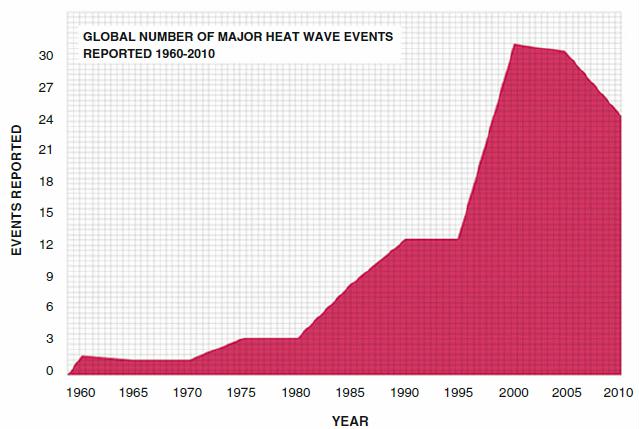
Global frequency of heat wave events. Source : National Academy of Sciences, graph
derived from EM DAT, International Disaster Database, Universite Catholique de Louvain,
Brussels
Ahmed, Nafeez. 2017. Failing States, Collapsing Systems BioPhysical Triggers of Political Violence. Springer.
“The last half century has seen a dramatic increase in the frequency and severity of extreme weather events in the form of droughts, wildfires, extreme rainfall, floods, hurricanes and tornadoes. The Met Office concludes that despite scientists’ reluctance to attribute specific extreme weather events to human-induced climate change, there is now no longer any doubt that climate change is making extreme weather increasingly likely all over the world (Stott 2016).
By far the most disturbing study led by the University of Hawaii argued that the pattern of escalating intensity and frequency indicates that anthropogenic climate change is rapidly pushing the climate system into a ‘new normal’, that breaks fundamentally with the preceding 150 years. The paper came up with the concept of “climate departure” to explain its prediction that in coming decades, the trajectory of escalating extreme weather signals that the climate is destined to ‘depart’ from the historical norm of weather as we have known it. On a business-as-usual trajectory, the initial locus of this “climate departure” will occur within the next decade in the tropics—that is, a vast region encompassing parts of the Middle East, Central Asia, South Asia and Africa. On a global scale, “climate departure”—the entry into a ‘new normal’ of extreme weather—will hit around 2047. Even under stringent carbon emission mitigation scenarios, this tendency to “climate departure” will not be halted—only postponed a few more decades, to around 2069 (Mora et al. 2013).
While the oceans are dying, above the oceans the atmosphere is already experiencing the direct impact of climate change in the form of intensifying heatwaves and extreme weather events. The increasing frequency—and increasing intensity—of heat waves is perhaps one of the most overt manifestations of the dangerous impacts of climate change. Since 1950, the number of heat waves worldwide has increased, heat waves have become longer, and the hottest days and nights are hotter than ever before. In recent years, the global area affected by summer heatwaves has increased 50-fold. Within the US, the direct impact of more frequent and intense heatwaves is an increasing frequency and duration in wildfires (Trendberth et al. 2012).
Heatwaves would likely occur 10 times more than they do now. Such intolerable conditions would endanger the lives of the regions’ 500 million inhabitants, and force people to migrate simply to survive (Lelieveld et al. 2016).
This means, very simply, that no matter what mitigation efforts look like on climate change, the coming decades will see increasing instability in the Middle East and North Africa, and an ever greater exodus from parts of the region into the Northern hemisphere. Intensifying climate-induced droughts and heatwaves will create conditions that no regional state will be able to cope with.
Food Production
Climate change is already dramatically affecting the global food system. Many of the extreme weather events in recent years have been concentrated in some of the world’s most critical food basket regions, contributing directly to prolonged crop failures that have been linked to global food price spikes and other phenomena. It is already known that anthropogenic climate change to date has had a debilitating impact on global food production, partly associated with the impact of more frequent extreme weather events on crop production. Total losses in national cereal production from 1964 to 2007 due to droughts and extreme heat likely caused or exacerbated by climate change have been estimated at 9–10% (Lesk et al. 2016).
Corresponding to the rising trends of increasing climate disruption and energy decline, recent decades have seen a marked increase in political violence worldwide. These outbreaks of political violence demonstrate that prevailing national state institutions and their domestic monopolies in the means of violence (which is the basic underpinning of state power as defined by the capacity to mobilize violence to control a defined national territory) are increasingly being challenged and undermined. In other words, what we are witnessing is a creeping acceleration of the forces of non-state political violence that directly weaken the very fundamentals of state power.
30 May 2012 by Michael Marshall. Extra heatwaves could kill 150,000 Americans by 2099. NewScientist.
[ My comment: Meanwhile, climate change will be causing blackouts and brownouts, so millions more won’t have air conditioning, which could lead to even higher death tolls].
By the end of the century, heatwaves caused by global warming could kill 150,000 people who would otherwise live.
A report by the US Natural Resources Defense Council (NRDC) estimates how many extreme heat events will hit the US this century, assuming greenhouse gas emissions continue on their current path according to the report – Killer Summer Heat: Projected death toll from rising temperatures in America due to climate change.
Climate models suggest that by 2099 the 40 most populous cities will have approximately eight times as many days of extreme heat per year as today.
The figure may actually be an underestimate, because the US population is ageing and older people are more vulnerable to heat. Louisville, Kentucky will be the worst affected city, with an extra 19,000 deaths by 2099.
The European heatwave of 2003 killed 35,000 people, so the report’s estimate is “not unrealistic”, says Andreas Sterl of the Royal Netherlands Meteorological Institute in De Bilt.
References
Lelieveld, J., Y. Proestos, P. Hadjinicolaou, M. Tanarhte, E. Tyrlis, and G. Zittis. 2016. Strongly Increasing Heat Extremes in the Middle East and North Africa (MENA) in the 21st Century. Climatic Change 137(1–2): 245–260.
Mora, Camilo, et al. 2013. The Projected Timing of Climate Departure from Recent Variability. Nature 502(7470): 183–187.
Stott, Peter. 2016. How Climate Change Affects Extreme Weather Events. Science 352(6293): 1517–1518.
Trendberth, Kevin, Jerry Meehl, Jeff Masters, and Richard Somerville. 2012. Heat Waves and Climate Change. https://www.climatecommunication.org/wp-content/uploads/2012/06/Heat_ Waves_and_Climate_Change.pdf
